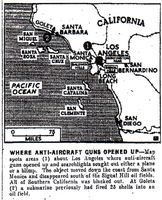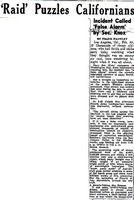
The Battle of Los Angeles
Not many people know that there was the Battle of Los Angeles, fought in the United States on February 25, 1942. The battle including anti-aircraft fire and collateral damage.
 The Galveston Daily News, Feb. 26, 1942 |
A map showing where the battle took place with anti-aircraft guns opening fire and identifying the object either as a blimp or a plane. The object was believed to have moved down the coast.
And herein lies the first interesting aspect of the battle, and that is the attempt to identify what, if anything, was being shot at. In this article it was either a blimp or a plane.
 Syracuse Herald Journal, Feb. 26, 1942 |
In this article it's said that there were 15 enemy planes in the raid, or at least so said the Secretary of War. The Secretary of the Navy, though, had said it was a false alarm.
1,430 rounds of ammunition were fired between 3:122 and 4:14 A.M. The Secretary of War said the planes were flying from a very slow speed up to 200 mph, and from 9,000 to 18,000 feet in altitude. No bombs were dropped an no planes rose to challenge the invaders, according to the article. Further, the Secretary of War claimed that the raid was to instill panic and/or determine the location of anti-aircraft guns.
 Reno Evening Gazette, Feb. 26, 1942 |
On the other hand, there's this article from the Reno Evening Gazette. Based on eye-witness reports, there were at least two waves of bombers, a total of 200 planes, which did drop bombs. Other witnesses thought there was only one wave of planes.
Looking where the searchlights were converging, witnesses either saw no planes at all, or something which looked like a “giant butterfly,” which they thought might have been a blimp.
Another witness said they saw a plane shot down.
So, either there were no planes or there were 200; either bombs were dropped or they weren't; either there was or was not a blimp; either no American planes were involved, or one plane (of one side or the other) was shot down.
Is this beginning to look confusing or not?
 The Galveston Daily News, Feb. 26, 1942 |
 |
Another article, another view of what happened. This time the Secretary of the Navy says the thing was a false alarm. Fourth Army HQ, though, are quoted as saying that the aircraft had not been identified. Flak fragments fell into residential neighborhoods, breaking one window but not injuring anyone.
One “official” source said that Army planes responded immediately; another “official” source said no planes got off the runways since they didn't want to be shot down by their own flak.
It was also the deadline for persons of Japanese ancestry to be out of the west coast prohibited zones, and the article notes eight Japanese being arrested as possibly having used lights to signal the aircraft. They were released when the lights turned out to be tracer fire.
The article also claims that flares were landing and had been fired by persons of Japanese ancestry in order to guide the planes.
One person at an aircraft factory had field glasses, looked at the scene of the attack, and says he didn't see any planes at all.
Other similar articles
 The Lowell Sun, Feb. 26, 1942 |
 The News (MD), Feb. 26, 1942 |
 The Oakland Tribune, Feb. 26, 1942 |
 Reno Evening Gazette, Feb. 27, 1942 |
 San Mateo Times and Daily News Leader, Nov. 2, 1945 |
| |